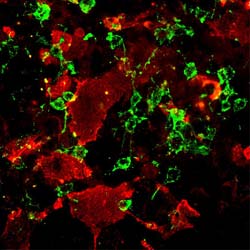The sweet mysteries of the nervous system: RUB-researchers develop new antibody for cell labelling

Two types of stem cells were stained with the new Bochum antibody 5750 (red) and the conventional antibody 487 (green). They can be clearly separated, since the antibodies recognise different LewisX sugar residues. © the American Society for Biochemistry and Molecular Biology.<br>
Researchers in Bochum have produced an antibody that allows them to distinguish the numerous types of stem cells in the nervous system better than before.
“In order to use stem cells for therapeutic purposes, it is important to be able to distinguish between the different types”, explained Eva Hennen of the RUB Department of Cell Morphology and Molecular Neurobiology (Faculty of Biology and Biotechnology). The antibody 5750 recognises a specific sugar residue on the cell surface, which is called LewisX.
The research group lead by Prof. Dr. Andreas Faissner has now been able to use LewisX for the first time to separate different types of stem cells. The researchers report on their results in the Journal of Biological Chemistry.
Unexpected sugar diversity
Antibodies that recognise the LewisX sugar residue are used routinely to identify so-called neural stem cells from which the various cells of the nervous system originate. Prof. Faissner’s team has now shown that the designation “LewisX” does not just cover a single sugar motif, but a whole range of different sugar residues. Different types of neural stem cells are equipped with individual combinations of LewisX sugar residues on their cell surface. The new Bochum antibody 5750 recognises a different LewisX sugar residue to the antibodies previously used. “This sugar diversity could also be interesting for cancer diagnosis” Prof. Faissner explained, “because LewisX sugars have also been detected on tumour cells”.
Identifying properties of stem cells
With the aid of the new antibody 5750, certain types of neural stem cells can be isolated from a mixture of different cell types. The aim of Prof. Faissner’s research group is now to examine the properties of the stem cells which carry the LewisX sugar residues. The researchers have already found out that the LewisX motif on the cell surface changes when the stem cells develop further – for example into oligodendrocytes, which form the insulation layer of the nerve cells, or into nerve cells themselves.
Bibliographic record
Hennen E, Czopka T, Faissner A (2011) Structurally Distinct LewisX Glycans Distinguish Subpopulations of Neural Stem/Progenitor Cells. The Journal of Biological Chemistry 286: 16321-16331. doi 10.1074/jbc.M110.201095
Further information
Prof. Dr. Andreas Faissner, Department of Cell Morphology and Molecular Neurobiology, Faculty of Biology and Biotechnology at the Ruhr-Universität, 44780 Bochum, Tel. 0234/32-14313, Andreas.Faissner@ruhr-uni-bochum.de
Edited by Dr. Julia Weiler
Media Contact
More Information:
http://www.ruhr-uni-bochum.de/All latest news from the category: Life Sciences and Chemistry
Articles and reports from the Life Sciences and chemistry area deal with applied and basic research into modern biology, chemistry and human medicine.
Valuable information can be found on a range of life sciences fields including bacteriology, biochemistry, bionics, bioinformatics, biophysics, biotechnology, genetics, geobotany, human biology, marine biology, microbiology, molecular biology, cellular biology, zoology, bioinorganic chemistry, microchemistry and environmental chemistry.
Newest articles

A universal framework for spatial biology
SpatialData is a freely accessible tool to unify and integrate data from different omics technologies accounting for spatial information, which can provide holistic insights into health and disease. Biological processes…

How complex biological processes arise
A $20 million grant from the U.S. National Science Foundation (NSF) will support the establishment and operation of the National Synthesis Center for Emergence in the Molecular and Cellular Sciences (NCEMS) at…

Airborne single-photon lidar system achieves high-resolution 3D imaging
Compact, low-power system opens doors for photon-efficient drone and satellite-based environmental monitoring and mapping. Researchers have developed a compact and lightweight single-photon airborne lidar system that can acquire high-resolution 3D…





















